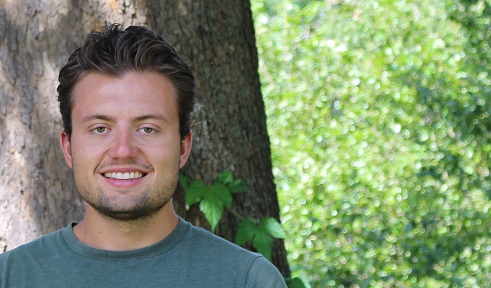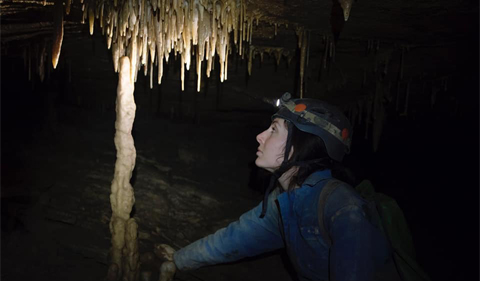
Andrew Hall
The Geological Sciences Colloquium Series presents Andrew Hall and Kelli Baxstrom, Geological Sciences graduate students discussing their research on Sept. 28 at 2 p.m. in Clippinger 205.
Hall presents “Verification of and Expansion Upon the Use of Cave Scallops in Recreating Hydrogeologic Conditions in Karst Aquifers”
Abstract: Turbulent flow across soluble bedrock can form concave dissolution features known as scallops. Scallops have been used to recreate paleoflow conditions in cave conduits by deriving floodwater velocities and discharge from scallop lengths. The continuity equation has been used to test the reproducibility of derived discharges from scallop lengths. We attempt to verify and extend the application of scallops in recreating paleoflow conditions in karst aquifers. We have measured scallops and performed Wolman pebble counts in five caves in Greenbrier County, West Virginia, and are performing statistical analyses on the measurements. We are using the scallop data to test for the constancy of flow rates throughout a given passage (continuity), uniform vs. non-uniform flow, the effect on scallop lengths due to vertical position in a cave passage, the effect of comparatively large scallop lengths (outliers) on the derived discharge values and finally correlations between sediment/pebble size and scallop-derived shear stresses in passages. Each of these hypotheses is being rigorously analyzed by comparing statistical distributions, means, and variances. The understanding of the complex nature of cave systems and karst aquifers will be significantly expanded by improving the usage and reliability of scallops. We will present the results of the above tests and place them in the context of previous studies.

Kelli Baxstrom
Baxstrom presents “Appalachian Ecosystem Response to Late Pleistocene Climate Change”
Abstract: The ground beneath Appalachian forests holds a history of climatic and biotic interactions. Extensive studies have shown stalagmites record moisture level fluctuations due to climate change (Springer et al., 2014). Additionally, pollen and spore assemblages have been used as proxies for paleovegetation composition, which can in turn be compared to the records of stalagmites. The moisture levels and climate indicators from these two proxies can be compared to illustrate and explain changes in vegetation. Moreover, the effects that localized vegetation changes had on megafaunal extinctions are themselves unknown. While extensive research on megafauna dispersal has been done in the American West due to well-preserved and easily accessible materials, previous work in the eastern U.S. is scattered and minimal. Data collected from caves near Lewisburg in Greenbrier County, West Virginia are synthesized with previous work discussing biodiversity changes to determine to what level climate-driven vegetation changes influenced on megafauna habitation and extinctions in central Appalachia in the Quaternary.
Upcoming Colloquia
Connor McFadden of Ohio University Geological Sciences on “Analysis of Landscape Variability Through the Pennsylvanian-Permian Monongahela and Dunkard Groups, Southeastern Ohio, USA and Sara Thurkettle of Ohio University Geological Sciences on “Reconstructing Paleofloods in the Bedrock Greenbrier River Using Slackwater Deposits and Hydraulic Modeling” on Oct. 21 at 2 p.m. in Clippinger 205.
Abiodun Ayo-Bali of Ohio University Geological Sciences on “Determination of Arsenic and Heavy Metals in the Environmental Phases of Barra de Santiago Marsh Barra de Santiago, El Salvador” and Lucas Howard on “Nutrient Loading from the Maumee River to Lake Erie” on Oct. 19 at 2 p.m. in Clippinger 205.
Ahmadreza Malekpour-Alamdari of Ohio University Geological Sciences on “Spatial and Temporal Variation of Continental Extension in Iran” on Oct. 26 at 2 p.m. in Clippinger 205.
Dawn Ruth of Ohio University Geological Sciences on “Open Questions on Open Vent Volcanoes: Case Studies of Llaima (Chile) and Mayon (Philippines)” on Nov. 30 at 2 p.m. in Clippinger 205.



















Comments